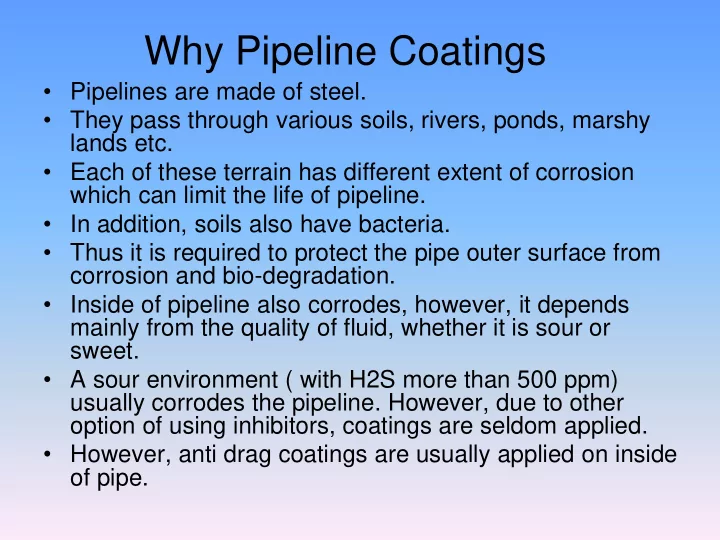

Why Pipeline Coatings • Pipelines are made of steel. • They pass through various soils, rivers, ponds, marshy lands etc. • Each of these terrain has different extent of corrosion which can limit the life of pipeline. • In addition, soils also have bacteria. • Thus it is required to protect the pipe outer surface from corrosion and bio-degradation. • Inside of pipeline also corrodes, however, it depends mainly from the quality of fluid, whether it is sour or sweet. • A sour environment ( with H2S more than 500 ppm) usually corrodes the pipeline. However, due to other option of using inhibitors, coatings are seldom applied. • However, anti drag coatings are usually applied on inside of pipe.
Critical issues in the Protection of pipelines • How oil pipelines differ from other lines • Types of coatings – important properties – High performance – Low permeability – High Dielectric constant – High Impact strength – High Cathodic Disbondment • Field joint coatings • Rehabilitation coatings
Coating Types • New Pipelines – Coal tar – Fusion Bond Epoxy – Three layer PE – Tapes • Rehabilitation – Tapes – Liquid Epoxy – Liquid Poly-urethane • Cathodic Protection
History of various line-pipe coatings 3 layer PE
Coal Tar Coatings • Possess continuity, hardness, adhesion, and corrosion resistance. • Are less expensive. • If complimented by a suitable cathodic protection system, they can give longer life. • Poor impact resistance. • A wide temperature change often causes the surface to crack. • However, due messy conditions at coating yard and fear carcinogenic vapour emitting, coaltar based epoxies are phased out in west. • In India also, a lot of coal tar coatings are being replaced by alternative coatings
Fusion Bond Epoxy Coating Single layer Coating Surface finish SA21/2 FBE coating thickness 350- 400 um High Cathodic Disbondment High Impact Strength (<10 J)
Why Fusion Bond Epoxy? • Long track record and experience • Better Corrosion resistance, • Lower thickness • Relatively easier application, • No chance of missing coating • High Resistance to Cathodic Disbondment • No Shielding effect and SCC or Pitting
Schematic of Fusion Bond Epoxy Shot Blasting Pre-heating Powder Coating Quality Check Quenching Transportation
Limitations of FBE • Handling is difficult Transportation Backfilling Improper storage
Three Layer PE Coating • Surface finish SA21/2 • 100-150 um FBE primer coat • 200 um Adhesive Coat • 1500 – 3000 um PE coat • Good Cathodic Disbondment • High Impact Strength ( 15 J)
Schematic of Three layer PE Coating Fusion Bonding Shot Blasting Pre-heating of Primer Epoxy Adhesive coat Quenching & Quality Check PE Extrusion Transportation
Three Layer PE Coating
Coating Conditions • Primer layer is applied by spraying electrostatically charged epoxy powder on heated pipes. The temperature should be within 190- 220 o C. • Adhesive layer which is a polyolefine is applied before the gel time of the epoxy coating. Its temperature about 220-230 o C. The main function of the coating is to bind the primary epoxy and the outer PE • On the Adhesive coated layer the PE is extruded over it. Its temperature is maintained at 238 o C.
Powder Coating of Epoxy Checking the Holidays Extrusion Coating of Adhesive & PE
Mechanism of 3 Layer PE System
Relationship between temperature of Epoxy coating and the time of adhesive coating Application Window 60 Time before application of adhesive 40 20 180 200 220 240 Pipe Temperature
Is there any problem with 3 Layer PE? • Not really - These coatings are one of the best coatings, however factors such as Their higher Cost Missing of FBE and/or adhesive coat . If proper care is not taken one can Repair is very costly compel to see alternatives
Indian Scenario • All pipelines buried in early fifties were either bare or coated with coal tar. • Coaltar was applied over ditch and it used to fail in aggressive environment – surface preparation and cleanliness was poor. • First major pipeline eracted by GAIL Inia in 1985 ( 2000km) was chosen as 3 layer PE. • Today 3 LPE is major metho, a few pipelines by FBE and still a large number by Coal-tar.
HBJ Pipeline Vijay Pur 3 Layer PE Coating Field Joint Coating
36” Pipeline Hazira 3Layer PE
3 Layer PE Coating Across Sabarmati River
Microstructure of dual FBE Coating
Effect of dual coating thickness on Cathodic Disbondment Resistance
FBE Coatings – Effect of Powder type on Impact Damage Resistance 350 um 350 um 500 um 500 um 500 um
Coating Economics Cost of Coating is typically 3-5% of the total project cost. – Choice of Applicator Location – Lower transportation and handling cost when it is close to site. – Selection of coating – a poor coating can run the risk of increasing construction cost, due to more repairs and delay in the project – Variation in thickness – Permeability and dielectric constant – Cathodic disbondment – Impact and abrasion – Testing of raw materials and Inspection during coating and installation – Custom duty and FE variation ( under Indian conditions)
Expenses during various categories for pipe coating Item % of total cost Right of Way(Survey, 2-5 clearance, damage) Materials (other than coating) 35-50 Labour 35-50 Engineering / inspection 3-5 Pipe Coating 3-5 Taxes / Transportation /legal 10-15
Relative application cost comparison for different Line Pipe Coatings (Ref. JPCL, Vol. 17, July 2000) Indian scenario – 3 LPE is cheaper than Single or dual FBE
Rehabilitation Coatings
Escavation and removing the old Coating
Recommend
More recommend